Note: This website was automatically translated, so some terms or nuances may not be completely accurate.
The Mahobin Memorial Museum: A Showcase of Professional Pride and the Spirit of Hospitality

Corporate museums occupy a buffer zone spanning both the academic realm of "museums" and the business realm of "corporations." They are organizations that collaborate extensively with corporate departments such as public relations, branding, advertising, and human resources. In this series, PR professionals will introduce various museums operated by corporations, exploring their roles, functions, and potential.
Cold water stays chilled even on hot summer days, and warm tea stays hot even on cold winter days. Thermos bottles have been a constant companion since childhood, at sports days and field trips. Whether out and about or at home, everyone has taken a moment to enjoy that refreshing or warming drink. We rarely thought about how thermos bottles work, but upon reflection, "magic bottle" is truly an apt name. Yet, there is no magic in manufacturing. This article explores the history and mechanism of thermos bottles while introducing the appeal of the "Thermos Museum."
Reporting and Text: Ikuyo Nakagawa (PR Consulting Dentsu Inc.)

A Hub for Communicating Thermos Technology and Appeal
In late August, with lingering summer heat still in Osaka, I visited the "Thermos Museum" in Tenma, Kita Ward. Located on the first floor of Zojirushi Mahoubin's headquarters, the museum is operated by the company. Before entering, the intense heat prompted me to take a sip from my own bottle to quench my thirst. My bottle, of course, was a Zojirushi. Even so, I couldn't help but marvel anew at how it could stay so cold and delicious despite the blazing sun.
The museum opened in 2008 to commemorate Zojirushi Mahoubin's 90th anniversary. It introduces the history of Japan's thermos bottle industry, from its pioneering days to its development and evolution, targeting the general public. It also displays approximately 350 items, primarily thermos bottles, collected from both Japan and abroad. Then, in 2018, celebrating its 100th anniversary, it underwent a renewal. A new exhibition corner was added, aptly named "The Forest of Thermos Bottles," featuring an impressive display of 110 thermos bottles differing in color, pattern, shape, and material.
This forest displays a diverse array of thermos bottles, from Arita ware to character designs. Lighting using glass inner bottles creates a unified, tranquil atmosphere. It features rare items, such as thermos bottles boasting a 100-year history, found only here, allowing visitors to fully enjoy the previously unknown world of thermos bottles.
The museum also introduces new technologies contributing to space development and various industries, including sports, reaffirming the high technical prowess of Japanese thermos bottles. The Thermos Museum truly serves as a base for disseminating thermos bottle technology and its appeal from Osaka to the nation and the world, representing the industry.
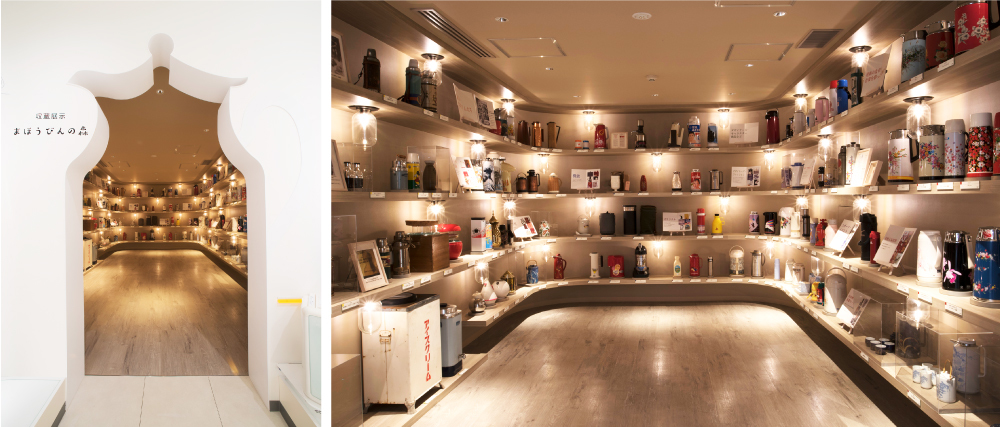
The reason for deliberately using "magic bottle"
There is a reason it is deliberately written in hiragana, not as "魔法瓶記念館" (magic bottle memorial hall). It stems from the desire for visitors of all ages, from young children to adults, to come and enjoy seeing the various products that have evolved with the times, each from their own perspective. At the entrance, a video picture book narrated in a gentle voice welcomes visitors, introducing the journey leading up to the invention of the thermos. It presents the history of humanity's ingenuity in keeping things hot or cold, from ancient times to the birth of the thermos, through richly nuanced animated visuals that children can understand. Yet, it feels very fresh even for adults.
Inside, the museum also features interactive exhibits like a vacuum experiment device that lets visitors experience the mystery of vacuum insulation firsthand. This makes it a facility where everyone, from children to adults, can enjoy learning with their eyes, ears, and whole body. Thermos bottles were once essential items for sports days and field trips, but today, regardless of age or occasion, many people, like myself, carry their own reusable bottles as a measure against heatstroke and for sustainability. This makes you realize anew that thermos bottles, with their excellent heat retention and cooling properties, have become indispensable in our daily lives.
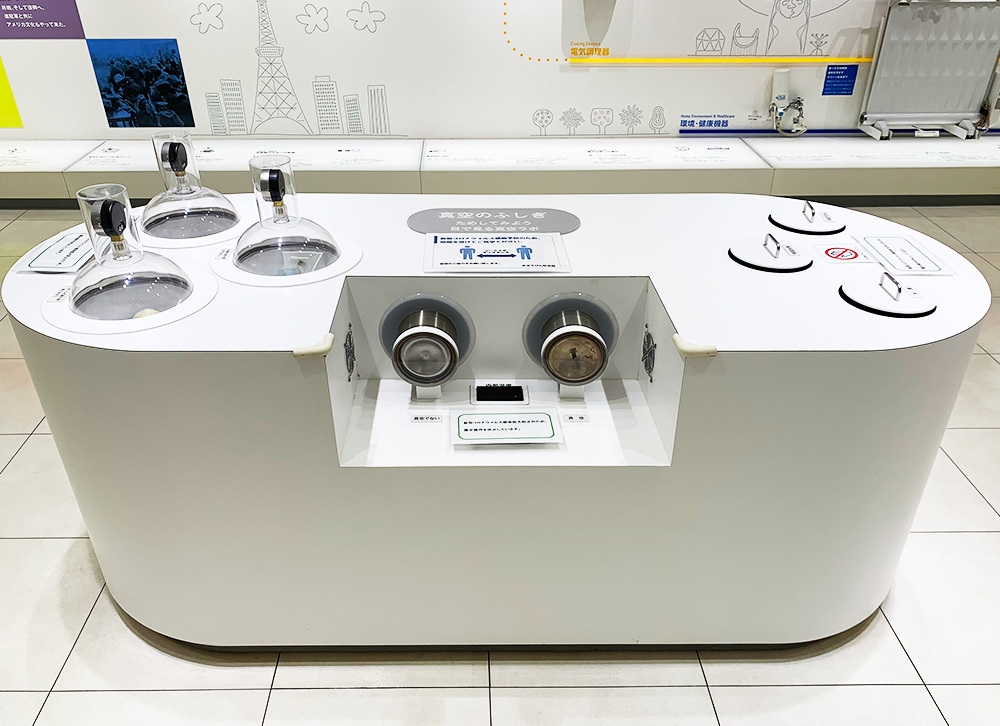
Guided tours available even for single visitors
There's another reason why this memorial hall was established on the first floor of the headquarters. Beyond its excellent transportation access, it serves as a tool for employee education and communication with business partners. However, what is particularly noteworthy is that, since its opening, all tours have been strictly reservation-only, with employees from the Public Relations Department personally serving as guides. Consequently, the museum is closed on weekends and holidays when the company is off, operating only on weekdays with three guided tours per day, each lasting about one hour. Even if only one person makes a reservation, they are treated as a group and receive the same level of service.
Is such a thorough approach common at other facilities? When we checked with Mr. Naoya Takayanagi of Taisho University, who specializes in researching corporate museums, he stated, "A fully reservation-based system where even a single reservation guarantees a guided tour by an employee is an extremely rare case. While this is common for corporate clients, the policy of always providing this service even for general visitors is uncommon among corporate museums." It represents the ultimate hospitality, prioritizing experience over efficiency.
The stance of valuing each individual visitor over visitor numbers is thoroughly implemented. However, in the current pandemic era, considering the infection risk from providing 40-50 minute explanations close to visitors, they now also offer a free audio guide via tablet with the same content for those who prefer it. English and Chinese options are also available, catering to international visitors. Since guides typically serve only one group per session, the museum previously had to turn away visitors from distant locations when reservations overlapped. The tablet system resolves this issue and has actually increased usage.
The History of Thermos Flasks: Zojirushi's 100-Year Legacy
Over 100 years have passed since the birth of vacuum insulation technology for heat retention and cooling. Inside the museum stands a replica of the flask that became the prototype for the thermos bottle. The "Dewar flask," invented in 1892 by British chemist James Dewar and named after him, is the symbolic exhibit of this memorial hall. It is a glass insulated container that utilizes the property that heat does not transfer in a vacuum, featuring a double-walled structure with the space between the inner and outer walls evacuated.
The vacuum flask, born in Europe, was introduced to Japan in the late Meiji period. Japan's vacuum flask industry developed primarily around Osaka, where the glass industry was thriving at the time. This is why many vacuum flask manufacturers still have their headquarters in Osaka today. One of these is the current Zojirushi Mahobin Co., Ltd. The founders were brothers Ginzaburo Ichikawa and his younger brother Kinsaburo (honorifics omitted hereafter). Kinsaburo, a craftsman specializing in light bulb processing, became interested in vacuum flasks. Together with his older brother Ginzaburo, he established "Ichikawa Brothers (Keitei) Shokai" in 1918 to manufacture the inner bottles for vacuum flasks.
Incandescent light bulbs were essentially the forerunners of vacuum technology, and there seemed to be a technical connection between manufacturing glass vacuum inner bottles and producing light bulbs. Eventually, they began the path from inner bottle manufacturing to producing their own vacuum flasks, leading to today's Zojirushi Mahoubin. Since then, the company has continuously evolved based on vacuum insulation technology. Throughout every era, it has drawn inspiration for product development from people's daily lives, delivering "convenience" and "comfort." The history of the vacuum flask is the history of Zojirushi itself. It is also a century that has transformed the very style of Japanese living.
The right side of the main hall introduces the history and technology of vacuum flasks, while the left side chronicles the company's journey. Among the many vacuum flasks that colored the times, you'll find familiar ones used in homes during childhood. Seeing the succession of products and reminiscing about the past is a unique pleasure of visiting the museum.
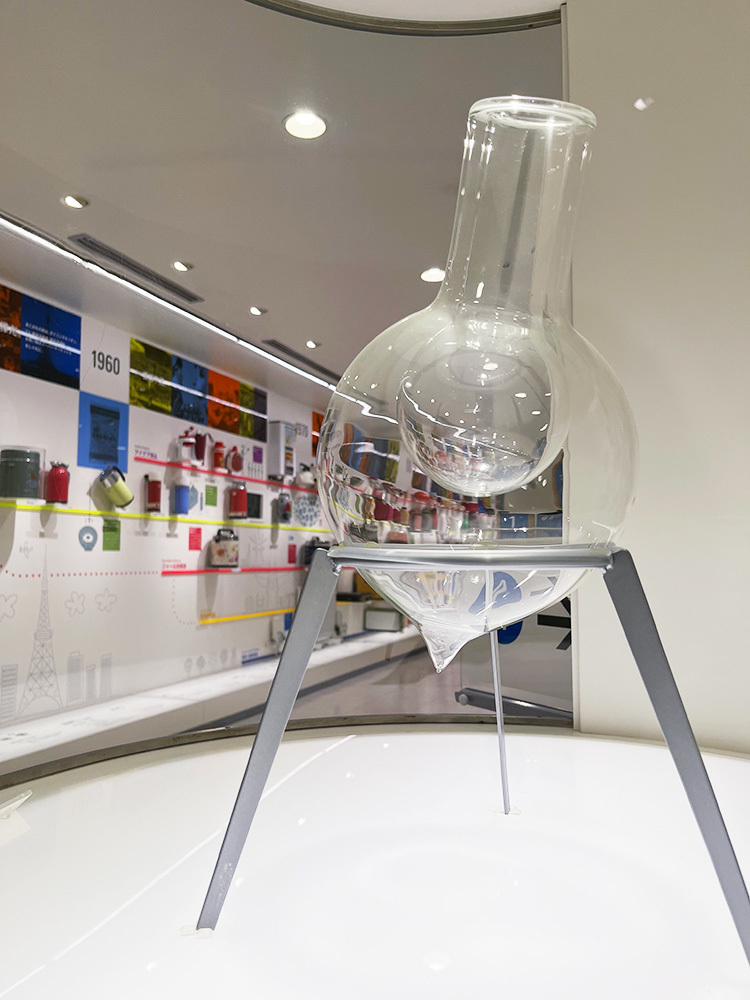
Before you know it, Zojirushi is part of your daily life
I'd also like to touch briefly on the Zojirushi brand. Five years after founding the company, in 1923, the first thermos bottle was finally completed. The trademark was decided to be an elephant mark, chosen because "elephants are popular with children, have a long lifespan, and symbolize strong family love." The first thermos bottle, engraved with "Zojirushi," was then released. Incidentally, since the initial demand came from overseas markets where drinking untreated water was unsafe (meaning people boiled water to drink), the elephant was chosen because it was beloved and even revered as sacred in Southeast Asia, the main export destination. For export models, the trademark "ELEPHANT&CROWN" was used, featuring an illustration of an elephant crowned with a crown. While the logo is simpler now compared to that era, the familiar elephant mark remains ever-present.

There is no end to manufacturing. We transitioned from glass to unbreakable stainless steel. As reusable bottles became mainstream, we pursued smaller, lighter designs. Our constant customer-first approach meant that even as a thermos company, we didn't limit ourselves to thermoses. Driven by the desire to create what people needed in each era, we ventured into making electric rice cookers with heat sources.
In 1970, the world's first electric rice cooker was launched, and the Zojirushi model became a huge hit. Many will remember it. This cooker, capable of keeping rice warm rather than letting it cool, undoubtedly warmed the hearts of those eating it during Japan's peak high-growth period – children waiting for their parents to return home, fathers coming back late from work.
Beyond this, products like the Watching Pot, equipped with a system to check on the safety of distant family members, demonstrate how addressing someone's "problem" is the origin of all their manufacturing. Their corporate philosophy, "Creating Daily Life," has remained unchanged since founding. Countless diverse Zojirushi brands have appeared in the world. Upon checking my own home, I found a Mug Bottle and two types of humidifiers were Zojirushi. Before I knew it, Zojirushi had blended into daily life.
A spirit of continuous challenge toward the future
As mentioned earlier, Zojirushi Mahobin's new technologies are being applied across various fields, including supporting space development and sports. In 2004, the company even ventured into space. Commissioned by JAXA (Japan Aerospace Exploration Agency), the company manufactured stainless steel vacuum-insulated containers for experiments on the International Space Station. These containers achieved the strength to withstand the intense 40G impact forces experienced during launch, demonstrating its high technological prowess to the world. For reference, the impact when a jet fighter lands on an aircraft carrier is said to be 7G, making the 40G impact truly unimaginable.
Also featured is the Zojirushi water bottle actually used by Mizuki Noguchi, the women's marathon gold medalist at the Athens Olympics. This athlete-specific marvel combines body cooling and hydration functions, reportedly prompting Noguchi to say, "This bottle saved me." As demonstrated by the various products evolving with the times, the spirit of continuous challenge toward the future remains unchanged even after 100 years.
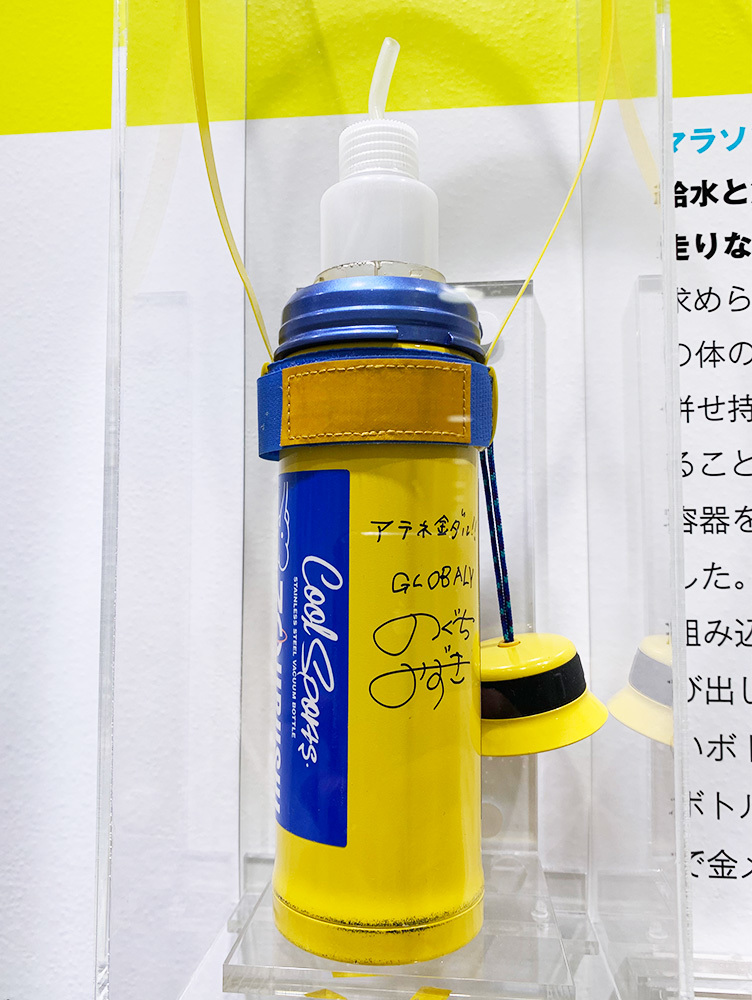
Delving deeper through captivating special exhibitions
Approximately 17,000 people have visited the memorial museum to date, despite it being open only on weekdays. When asked about the reason for this popularity, Director Kazumi Sugiyama mentioned that, in addition to the permanent exhibition, the limited-time special exhibitions are also drawing crowds. "The current 'Ocean and My Bottle Exhibition,' originally scheduled from last November to this April, has been extended until December 27th due to its popularity," she said.
She added, "The thermos bottles everyone uses daily are products that keep drinks hot or cold without using any energy. Unlike disposable PET bottles, they are eco-friendly products that reduce plastic waste and contribute to CO2 reduction through repeated use. We hope this exhibition helps people rediscover this fact and consider what we can do now. We plan to continue using various special exhibitions to share more about thermos bottles, which are so familiar in daily life."
I see. The special exhibition itself serves as a medium. The message they wish to convey is likely reaching visitors more deeply through these exhibitions, prompting them to consider environmental issues and leading to repeat visits. (Currently, exhibition explanations are provided only upon request due to COVID-19 countermeasures.)
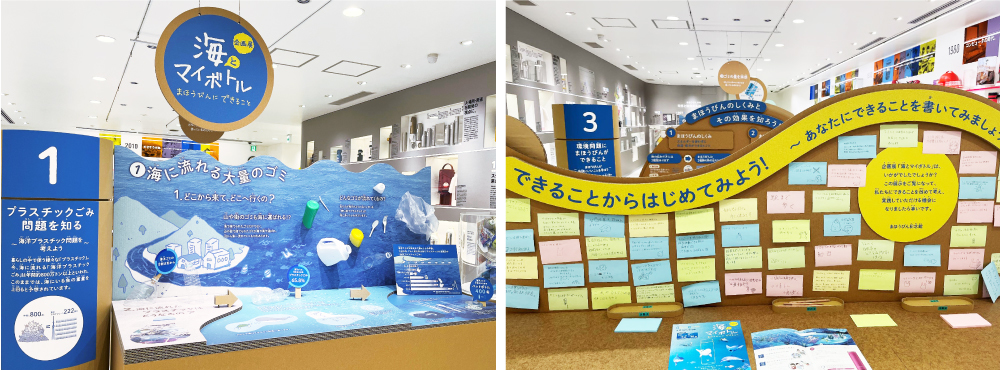
The Meaning Behind Keeping "Mahōbin" in the Company Name
Finally, we asked why they continue to include "Mahobin" in their company name. While the company has already brought a wide variety of products to market, and many companies change their names around their 100th anniversary, what is the reason for this? "To be precise, we've changed our name twice since our founding as 'Ichikawa Brothers Trading Company'. However, since the company began with the manufacture of the inner bottles for vacuum flasks, that is our company's roots. We continue to include 'Mahobin' in our company name because it has been, and remains, our flagship product."
Hearing this made it clearer what the company values most. For a thermos company, it begins with thermos bottles – keeping hot things hot and cold things cold – and a passion for "managing heat for our customers." And from there, a commitment to continuously pursue ways to enrich daily life. Everything is for the customer. Their stance of valuing each individual visitor surely extends equally to customers outside the museum. This is something only possible when employees take pride in the Zojirushi brand built over 100 years, and further, when they combine that with the professional pride to deliver their best performance in their respective roles to satisfy customers. This passion was palpable in the guide's explanation.
Perhaps their system doesn't chase visitor numbers; instead, when just one visitor feels personally connected and becomes a brand ambassador, sharing Zojirushi's story with others, fans naturally multiply. I sensed Zojirushi's strength.
For details on the Mahoubin Museum, visit:
For Zojirushi Mahoubin Corporation's website, visit:
[Editor's Note] (From the Web Dentsu Inc. Editorial Department)
As children, we all yearned for "magic." The cool techniques wielded by tokusatsu heroes, the fairy-tale-like spells cast by anime girls—all were "magic." As we mature, we learn the limits of human ability. We can't transform or fly. That's precisely why we long for "magic," I believe.
The true nature of Zojirushi Mahobin's magic is "vacuum." It removes the air essential for human life, replaces it with the moisture essential for human life, and maintains temperature. This technology extends beyond daily life, reaching into the world of athletes and even into space. It truly is "magic."
In the online or virtual world, we can now experience quite a bit of "magic." With VR, you can warp to the Warring States period or even outer space. Yet in the real world, most of what we dreamed of as children remains unrealized. There's no time machine, and flying carpets haven't been invented either. It struck me anew how remarkable the company Zojirushi Mahoubin is, and how incredible their product is, for having realized "magic" in the real world a hundred years ago.
Was this article helpful?
Newsletter registration is here
We select and publish important news every day
For inquiries about this article
Back Numbers
Author

Nakagawa Ikuyo
PR Consulting Dentsu Inc.
Integrated Communications Bureau
Chief Consultant
Long experience in planning, organizing, and executing PR events for government agencies and corporations. After returning from childcare leave, worked in the management department to promote operational efficiency, including employee work practices and knowledge sharing. Also involved in developing the company's corporate philosophy. Currently supports internal and external branding while planning and executing internal initiatives. Co-authored books include "Welcome to the Corporate Museum" (Jiji Press) and "Proposals for PR 4.0" (Sendenkaigi). Certified PR Planner by the Japan Public Relations Association.




